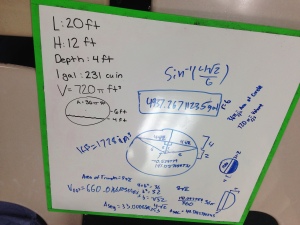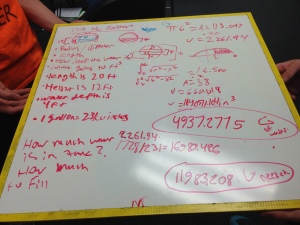Less Really Is More
Karen Hyers
Tartan High School
MCTM VP At-Large
I attended NCSM/NCTM week in Boston this spring. The opportunity to hear from so many of our profession’s leaders during a three-day conference is phenomenal. I left with a lot of big ideas to ponder for the summer, and I am looking forward to continuing the conversation at the Minneapolis NCTM Regional in November.
But, as a full-time classroom teacher, I look for that one new thing to bring back and implement with my students right away. For me that moment was when Dan Meyer said, “You can always add. You can’t subtract.” I have been developing a more student-centered instructional style and had not found a way that worked for me to introduce open-ended tasks. I had the fortune of attending a seminar facilitated by the now Dr. Meyer that focused on one of his 3-Act Math Tasks. He demonstrated the teacher moves that got us teacher-students to ask and answer our own questions in a way that I could adapt and apply. The results with my students are very positive, so I will share my process with you.
The first step is to start with an interesting potential problem. My sources have included: Meyer’s Math in 2 Acts, NCSM’s Great Tasks, You Cubed’s Low Floor High Ceiling Problems, Yummy Math, Advanced Placement released Free Response questions, and my current textbooks. Choose something that includes a visual (graph, table, picture, video) or a story.
Next, remove the question. And the labels. And the numbers. Think back to: “You can always add. You can’t subtract.” Too often math word problems can be solved by basic arithmetic using the two (or three) numbers presented. Leave enough information to make the situation intriguing, but not so much information that everything is predictable.
Get the students to formulate the question of the day. I ask my students to jot down what they notice and what they wonder. They share with their groups and then the whole class. Then they work together to pose mathematical questions that could be answered. I guide the group towards something that will work with the day’s objectives and leave other options as extensions for groups that finish quickly. If the problem involves making a choice between options, ask the students to make a prediction now.


Ask the students to determine what other information they need to solve the problem. Answer their questions. This is where you add back in the parts that you had subtracted. Give them the information they will need or a way to get it themselves.
Let the students solve the problem (and any extensions that they find interesting). Mine work in groups, usually on large whiteboards. Have someone from each group take a snapshot of their work. Bring the entire class back together to determine the answer to their problem before class is over. I usually get a volunteer group to present their board, and then ask for alternate methods. If the students predicted the outcome, determine who guessed correctly at the start for bragging rights!

